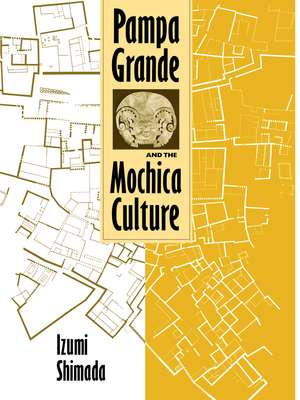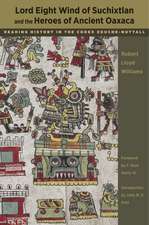Pampa Grande and the Mochica Culture
Autor Izumi Shimadaen Limba Engleză Paperback – dec 2009
This book presents a "biography" of Pampa Grande that offers a reconstruction not only of the site itself but also of the sociocultural and economic environment in which it was built and abandoned. Izumi Shimada argues that Pampa Grande was established rapidly and without outside influence at a strategic position at the neck of the Lambayeque Valley that gave it control over intervalley canals and their agricultural potential and allowed it to gain political dominance over local populations. Study of the site itself leads him to posit a large resident population made up of transplanted Mochica and local non-Mochica groups with a social hierarchy of at least three tiers.
Preț: 369.63 lei
Nou
Puncte Express: 554
Preț estimativ în valută:
70.73€ • 73.85$ • 58.40£
70.73€ • 73.85$ • 58.40£
Carte tipărită la comandă
Livrare economică 15-29 aprilie
Preluare comenzi: 021 569.72.76
Specificații
ISBN-13: 9780292723375
ISBN-10: 0292723377
Pagini: 341
Dimensiuni: 216 x 279 x 15 mm
Greutate: 0.77 kg
Editura: University of Texas Press
Colecția University of Texas Press
ISBN-10: 0292723377
Pagini: 341
Dimensiuni: 216 x 279 x 15 mm
Greutate: 0.77 kg
Editura: University of Texas Press
Colecția University of Texas Press
Notă biografică
Izumi Shimada is Distinguished Professor of Anthropology at Southern Illinois University in Carbondale.
Cuprins
- Preface
- 1. The Mochica and Pampa Grande in Andean Prehistory
- 2. Archaeology of the Mochica Culture: Growth and Characteristics
- 1. Early Scholarship
- 2. Emergence of Peruvian and Peruvianist Scholarship and the Recognition of Pre-Inca Cultures
- 3. Systematization and Modern Trends
- A. Establishment and Character of Collections
- B. Relative Chronology
- C. Iconographic Studies
- D. Defining Environmental and Architectural Settings: Settlement-Pattern and Related Studies
- E. Other Modern Advances
- 4. The Chan Chan–Moche Valley Project
- 5. The Royal Ontario Museum Pampa Grande Project
- 6. Retrospect and Prospect
- 3. Mochica Land and Culture
- 1. The Central Andes
- 2. Mochica Land in Central Andean Context
- A. The Diversity of Vertically Differentiated Microenvironments
- B. Proximity to the Equator: Altitude-Latitude Interplay and Ramifications of Tropical Alpine Conditions
- C. Proximity and Importance of the Pacific Ocean
- D. Llama Breeding and Herding on the North Coast
- E. Unpredictable Forces and Dynamic Perception of the Environment
- F. Creative Cultural Solutions to Environmental Limitations
- G. Highland Rains and Coastal Water
- 3. The North Coast: A Summary Characterization
- 4. The Lambayeque Valley Complex, the Moche V Heartland
- 4. Mochica Culture before Pampa Grande
- 1. North Coast Antecedents of the Mochica Culture
- A. Cupisnique
- B. Salinar
- C. Gallinazo
- 2. Emergence of the Mochica Culture
- A. Emergence of the Mochica Style
- B. Chronological and Geographical Origins of the Style and the Associated Polities
- C. The Problematics of the Vicús-Mochica Style
- D. Sociopolitical Conditions Surrounding the Emergence of the Mochica Style and Polities
- 3. Developments during Moche III (ca. A.D. 378–450)
- A Territorial Expansion to the South
- B Northern Sector and the Sipán Enigma
- C. Summary
- 4. Developments during Moche IV (ca. A.D. 450–550)
- A. The Southern Sector
- B. The Northern Sector
- 5. Mochica Horizontality
- 6. Mochica Verticality: Peer Polity Interaction?
- A. Mochica-Recuay Interaction
- B. Mochica-Cajamarca Interaction
- 1. North Coast Antecedents of the Mochica Culture
- 5. Mochica Organizational Features
- 1. Developments at the Capital of Moche
- 2. Socioeconomic Features of the Mochica Culture
- A. Labor Organization and Corporate Projects
- B. Social Organization
- 3. The Nature of Mochica Political Organization
- A. Defining the State
- B. Case for the pre–Moche V State
- C. Critical Assessment
- D. Alternative View: Chiefdom-Level Polity
- E. Summary
- 4. Mochica Urbanism before Pampa Grande
- 5. Mochica Culture before Pampa Grande: A Summary Characterization
- 6. The Establishment of Moche V Pampa Grande
- 1. Abandonment of the Southern Sector
- 2. Abandonment of the Site of Moche
- 3. Inland and Northward Settlement Shift
- 4. Moche V Domain: A General Characterization
- 5. Climatic Data
- A. Central Coast
- B. South Coast
- C. Quelccaya Ice Core Data
- D. Applicability of the Quelccaya Data to the North Coast
- 6. The Moche IV–V Transformation as a Response to Severe Droughts: Archaeological Assessment
- A. Chronological Consideration
- B. The Selection of Pampa Grande and the Lambayeque Valley
- C. Assessing Other Related Issues
- 7. Assessing the “Wari Expansion” Hypothesis
- A. Relevant Evidence and Arguments
- B. Assessment of the Model
- 8. Conclusion
- 7. Urban Landscape at Pampa Grande: Architecture and Sociopolitical Significance
- 1. Defining the City
- 2. Physiography of Pampa Grande
- 3. Architectural Forms and Hierarchy
- 4. Sector Characterizations
- 5. Organizational Principles of Urban Architecture
- A. Symbolic Significance of Huaca Fortaleza
- B. The Axis Mundi and Four-Tier Hierarchy of Huacas and Compounds
- C. Regulation of Movement
- D. Height Differentiation
- E. Adobe Brick Construction
- 6. Emergence of the City and State: Factors and Processes
- A. The Traditional Ceremonial-Civic Center as the Organizational Framework
- B. Construction Techniques and History of Huaca Fortaleza
- C. Organizational Implications of Huaca Fortaleza and Other Major Corporate Constructions
- 7. The Composition and Permanence of the Pampa Grande Population
- A. Establishing Permanent Residency: Demographic Correlates of the Huaca Fortaleza Construction, Agrarian Reform and Social Surplus
- B. Social Organization of the Urban Residents
- C. Summary
- 8. Urban Subsistence and Economy at Moche V Pampa Grande
- 1. Subsistence Items: Riches of the Land and Sea
- A. “Garbage” and the Nature of Organic Remains at Pampa Grande
- B. Plant Resources
- C. Marine Resources
- D. Domesticated Animals
- 2. Procurement and Distribution of Subsistence Items
- A. North Coast Llama Breeding and Herding
- B. Agricultural Produce
- C. Marine Products
- D. Differential Distribution of Subsistence Items
- 3. Craft Goods and Production
- A. Characterization and Differential Distribution of Ceramic Types
- B. Ceramic Production and Workshops
- C. Metal Objects and Metalworking
- D. Weaving and Textiles
- E. Bone and Stone Artifacts
- F. Spondylus and Other Shell Objects
- 4. Redistributive Nature of the Moche V Urban Economy
- A. Centralized, Differentiated, Large-Scale Storage
- B. The Redistributive Economy in Operation: Chicha and Craft Production
- 5. Organization of Craft Production: Summary
- 1. Subsistence Items: Riches of the Land and Sea
- 9. Art and Religion
- 1. Moche V Art Style and Iconography
- A. Skewed Data Base and Basic Features
- B. Characteristics of Moche V Ceramic Art
- C. Thematic Sequence
- D. Moche V Murals at Pampa Grande
- 2. Ritual and Mortuary Practices
- A. Spondylus Shells and Moche V Rituals
- B. Human Sacrifice and Trophy Heads
- C. Moche V Burials
- D. Changes in Mochica Burial Practices
- 3. Understanding Moche V Art and Religion
- 1. Moche V Art Style and Iconography
- 10. The Demise of Moche V Pampa Grande
- 1. Demise of the Moche V Polity and Mochica Abandonment of Pampa Grande
- A. Intentional, Synchronic, Selective Burning of Key Structures
- B. Explaining the Collapse and Abandonment: General Considerations
- C. Specific Causes of the Collapse and Abandonment
- D. Assessing the Models of Specific Causes
- 2. Disintegration of the Moche V Culture on the Northern North Coast
- 1. Demise of the Moche V Polity and Mochica Abandonment of Pampa Grande
- 11. Moche V Legacies and Conclusion
- 1. Legacies of the Mochica Culture and Pampa Grande
- A. Art and Religion
- B. Territorial Expansion, Cultural Interaction, and Human-Environment Interplay
- C. Redistributive Economy and the State
- D. Monumental Architecture and Attendant Institutions
- E. City and State Formation
- F. Mochica and Chimú Dynastic Continuity?
- 1. Legacies of the Mochica Culture and Pampa Grande
- Notes
- Bibliography
- Index
Recenzii
In Shimada’s elegantly illustrated, well argued and documented book, he undertakes the task of exploring the complex causes for the transition registered between Moche-IV and Moche-V, and for the rise and fall of [the] last great Mochica civic experiment, Pampa Grande. But far more is offered, for Shimada embarked on a brilliant critical re-evaluation of what is known and still enigmatic about the long-lived Mochica cultural tradition in the Peruvian North Coast.... .Using a multidisciplinary approach Shimada weaves a richly patterned tapestry of Mochica prehistory. It is required reading for archaeologists interested in Latin America.
[Pampa Grande and the Mochica Culture] demonstrates what archaeologists can achieve in terms of reading cultural meaning from the material record. . . . Clear, thoughtful, detailed, and balanced, it is one of the finest treatments of a prehistoric culture that I have ever read.
Descriere
This book presents a "biography" of an ancient Moche city that offers a reconstruction not only of the site itself but also of the sociocultural and economic environment in which it was built and abandoned














